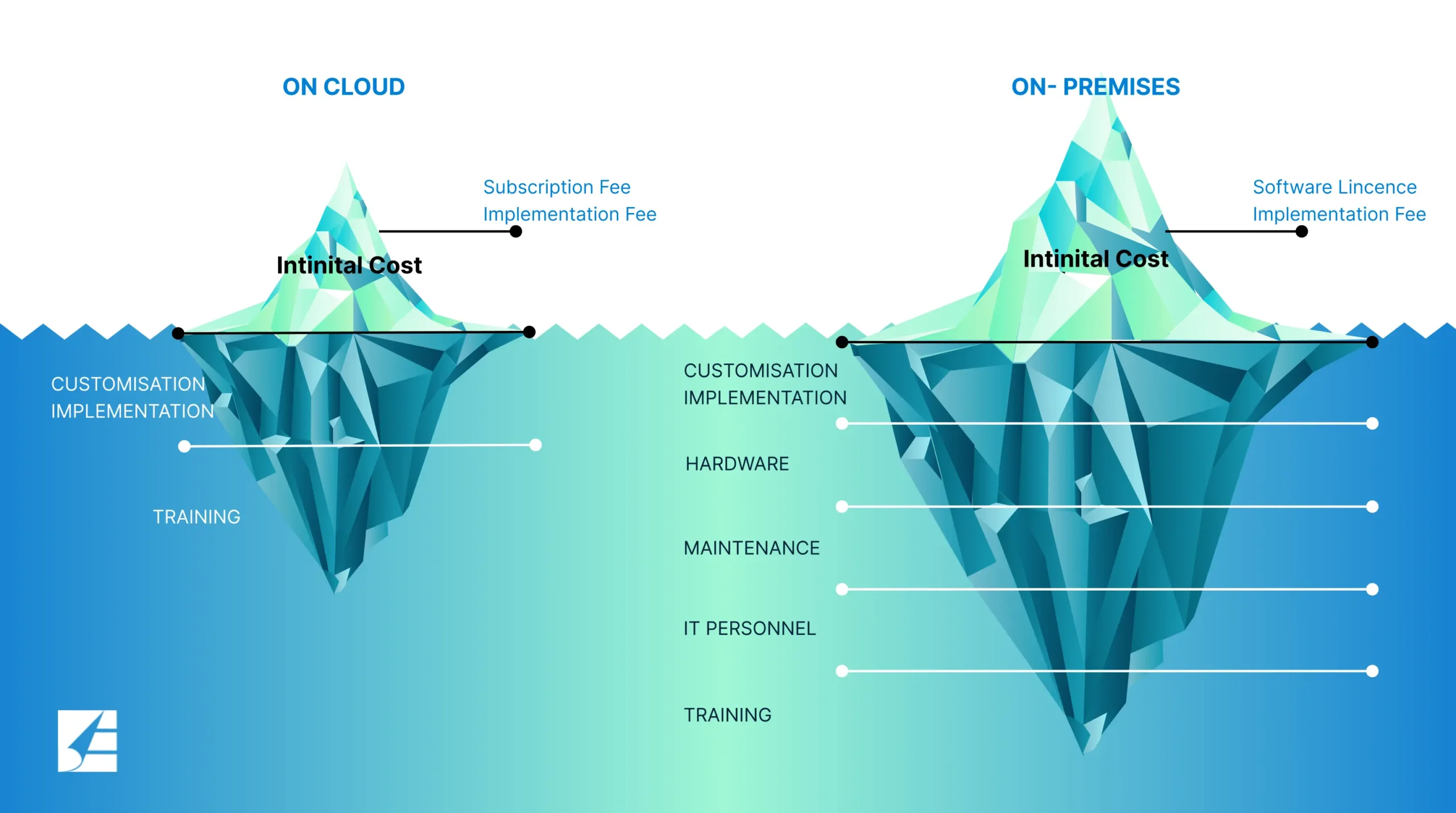Are you comparing Cloud vs on-premise and considering moving your business to the Cloud? If so, you’re not alone. Cloud computing is a rapidly growing trend, and for a good reason.
But before you make the switch, it’s essential to understand the pros and cons of both Cloud and on-premise solutions. This article will break down the key differences between these two types of systems, so you can decide which is right for your business.
Keep in mind that there is no one-size-fits-all answer; every business is different, and each will have its own unique needs. This article should help you evaluate your specific situation and then choose the option that best meets those needs.
What is Cloud Computing?

Cloud computing, also called “software as a service” (SaaS), provides immediate, always-on access to the solution and is typically paid for via a monthly subscription.
Since they are multi-tenant, only your data may be unlocked, but you still access a single set of resources, an application infrastructure, and a database while using them.
Since you do not purchase, license, or operate the underlying hardware, software, or networking infrastructure, there are no up-front costs, capital investments, or long-term commitments.
The provider carries out upgrades without charging you extra. Your customizations “roll over” to operate with the next version, even if you make significant modifications to the system.
What is On-Premise?

In this conventional system, you purchase software licenses and execute them on your servers.
When considering this approach, consider the capital and operating costs related to deployment, operations, support, customization, integration, maintenance, and updates.
While these expenses may be too high for small and midsize businesses, on-premise solutions are still an option for certain larger businesses. These companies frequently have a well-developed IT infrastructure, funding, and the knowledge necessary to operate and manage large software programs.
Cloud vs On Premise Pros and Cons, And Key Differences
On-Premise
On-premise software gives you more control over your data and your applications. You can customize your applications to meet your specific needs, and you can be sure that your data is stored securely on your premises.
However, on-premise solutions can be more expensive to set up and maintain, and they typically require more IT resources to manage.
Cloud
Cloud solutions, however, are more affordable and easier to set up and maintain. They also offer greater flexibility since you can access your applications and data anywhere with an internet connection.
However, you give up some control over your data when you choose a cloud solution – specifically, you have to trust that the vendor will keep your data safe and secure.
=> Related article: How a cloud application could boost employee productivity?

Cloud vs On Premise: Key Differences
There are a few key differences between on-premise and private Cloud models that you should keep in mind when choosing a software solution for your business.
- Deployment
On-premise software is installed on the customer’s hardware and is typically managed by the customer.
On the other hand, cloud software is delivered via an internet connection and is managed by the vendor.
- Customization
On-premise software customization can be expensive and time-consuming. The possibility of “dead-end” modifications breaks when new software versions are available.
In contrast, clickable setups in the Cloud replace expensive customization and are unaffected by application changes.
- User interface
On-premise software is frequently not designed for simplicity of use and learning since it is designed for Windows computers in a client/server environment.
Cloud is created entirely from scratch for the Web environment to adhere to the paradigm that users are used to and anticipate. It is designed from the ground up to be simple to use across various devices and operating systems.
- Hardware requirements
A specialized operating environment is needed for on-premise software.
Cloud services are delivered through a web browser, making the operating system and browser independent.
- Cloud vs on-premise cost
The price you pay for Cloud and on-premise infrastructure depends on several things. This makes it impossible to say for sure which environment is less expensive.
Sometimes, on-premise is less expensive, depending on a business’s demands. There are many other circumstances in which the Cloud is less costly.
- Cloud vs on-premise security
Although on-premise security measures have always been more robust, cloud computing is no longer a cutting-edge technology. More and more companies today rely on the Cloud for their security requirements. A business that manages its on-site servers maintains greater security control.
Considering moving from On-Premise to Cloud
When installing corporate software, the Cloud offers compelling and unequaled advantages. Because of the capacity to access and analyze vast volumes of data in almost real-time, demand for cloud-based solutions is increasing.
These solutions require adaptable and agile applications that are comparatively simple to adopt, configure, and update, top digital transformation (DX) firms have shifted their focus to SaaS and cloud-enabled software rather than continuing to invest in outdated, on-premise systems.
With speed as a leading element in gaining business globally, firms demand and need more from their systems than ever before, including the most powerful and up-to-date systems available in SaaS and cloud-enabled systems.
To see if the Cloud is a good fit for your company, look back to the benefits of Cloud vs on-premise, and use the following inquiries to assess the situation quickly.
=> Related Article: Is moving from On-premise to Cloud a good idea?
Do the members of my team need to work remotely?
Accessibility “anytime, anywhere” is a significant advantage of switching to the Cloud. The entire team only needs a common and secure Web browser and an internet connection to work anywhere—in the office, at home, nearby, or around the world.
=> Even your employees are working remotely or not, you can still measure the employees productivity.
Does my company need to speed up financial operations without hiring more staff or spending more on IT?
High ROI and speedy payback are frequent with cloud applications. Avoiding construction expenditures and running costs related to an on-premise system has significant financial benefits.
But cloud computing also generates higher ROI by streamlining processes and saving time. Necessary financial procedures, including collections, consolidations, and period closes, are substantially accelerated by cloud systems since they are essentially web-based, life, and real-time.
Modern cloud-based solutions also include powerful automation and integration features. You may significantly increase productivity by getting rid of time consuming tasks like manual data input, paper-based procedures, and spreadsheet upkeep.
=> You might need: How to measure and calculate ROI by software?

Does Salesforce.com or another application need to interface with my finance system?
Easy integration is a given when using the Cloud. Cloud systems may be integrated thanks to APIs and Web services, allowing your organization to leverage the best apps for each functional area of the enterprise. That entails an end to expensive IT resources’ pricey custom programming and upkeep.
Are my managers interested in or need self-service access to the relevant KPIs?
Modern cloud systems excel at real-time visibility. Traditional users from the finance department and other company stakeholders can have access.
For instance, many financial services companies using cloud financials give their management team access to real-time dashboards so that everyone can see the relevant KPIs for their department.
The ability to see dashboards, enter and approve spending, and make purchase orders is provided by specific systems, while others grant access to various employees.
Some also provide access to third parties, like board members, auditors, CPAs, and lenders, enabling vital real-time information to forge trust-based relationships.
=> This is how you can: Upgrade your management skill.
Does my company have a problem with ineffective procedures?
Your organization can become more operationally efficient with the aid of the Cloud. Traditional financial procedures, such as closes and consolidations, can be streamlined.
However, you can use it to link in other business operations and procedures, your clients and suppliers.
For instance, you may plan workflows for purchases that involve all parties. You can provide a complete order-to-cash procedure that links sales and finance. You may also design budget dashboards for department managers to improve operational coherence.
Do we have to compete against larger companies with a tighter budget?
You can use a cloud-based financial system to get top-notch infrastructure. To maintain world-class infrastructure and offer you 24×365 operations, continuous backups, disaster recovery, and enhanced security, your digital adoption solution’ vendor amortizes expenses among thousands of customers.
This provides you with performance, reliability, and security level much higher than what you might be able to get on your own.
Additionally, cloud systems are both upward and downwardly scalable and may be provided instantly to start swiftly and change direction suddenly.
OPUS provides a Cloud computing environment – Be with OPUS
If you’re using Oracle User Productivity Kit (UPK) and are unhappy with it, there’s a tool that can help. That is Opus!
- Opus can take your existing content and convert it into a format that’s easy to use and edit. You won’t have to recreate your content from scratch, and you can salvage what you’ve already created.
- The process is simple: drag and drops your files into Opus, and they’ll be converted in bulk.
- You won’t need to live with static content anymore; once it’s in Opus, you can easily update and edit it as needed.
- You can deliver it in-application so your users can get the help they need exactly when they need it.
With Opus, there’s no need to keep using Oracle UPK if you’re not happy with it.
Opus vs UPK Comparison

Environment
Opus operates in the Cloud; thus, installing a server or client on-premises is no longer needed. Users pay a set price, and there are no maintenance or support fees.
Oracle UPK is a legacy on-premises application that needs to be installed on a local server. Additionally, access to and administration of servers and databases are required. In addition to licensing fees, there are yearly maintenance and support fees.
Ease of use
Opus simply makes content distribution and publishing for us because of its one-click functionality. Not technically savvy users can readily customize templates for content output thanks to modern UI’s straightforward delivery of powerful capabilities.
Oracle UPK is more complex because of its legacy user interface, which had its last major release in 2014. To customize templates, intensive product training is necessary. The implementation of publishing is complicated and needs a second server.
Project, team, and asset management
Opus offers asset, team, and project management. Users can directly access the program to create and manage projects, teams, and material. Collaborative authoring allows for the use of SME knowledge.
Additionally, emails created by the system guarantee that everyone is aware of deadlines and deliverables.
On the other hand, there is no built-in project, team, or content management in Oracle UPK. As a result, involving SMEs in creating or evaluating content and no system-generated emails is not easy.
To conclude,
Deciding to move to the Cloud or stay on-premise is not always accessible. Both systems have pros and cons, but it finally comes down to what will work best for the actual condition of your business.
We’ve outlined the key differences between Cloud and on-premise solutions in this post, so you can decide which option is right for you.





